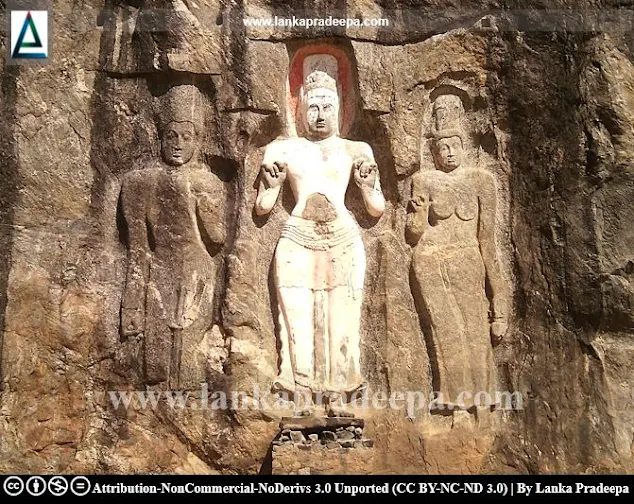
Buduruwagala (Sinhala: බුදුරුවගල; Tamil: புதுருவகல) is an ancient Buddhist monastery complex situated in Monaragala District in Sri Lanka. The temple is located about 2.5 km far from the Buduruwagala junction on Wellawaya-Thissamaharama main road.
The monastery complex

Buduruwagala is a protected archaeological reserve consisting of two sites (Nimal, 2011). The first site, located adjacent to the Buduruwagala Wewa, is a ruined monastery complex. It contains a Stupa, remnants of a boundary wall, and several other buildings. The second site contains the famous Mahayana sculptures carved on the Buduruwagala rock which is located about 0.5 km far from the first site.
A group of colossal figures is found cut on the face of the Buduruwagala rock. There are seven figures sculptured in a bas-relief manner and the size of them is comparable to that of the Buddha statues at Avukana and Sesseruwa (Nicholas, 1963). Among the seven statues, six are Bodhisattva images while the other is a Buddha statue (Deegalle, 1998). The figures were originally given a coating of paint, traces of which are still visible in some places (Nicholas, 1963). These figures are thought to be a work of Mahayana tradition belonging to the 7-9 centuries A.D.
The central figure of the group is a standing Buddha statue showing the Abhaya Mudra by its right hand. While holding the robe, the left hand depicts the Kataka Mudra. The statue is about 13 meters tall and believed to be the tallest Buddha image (ancient) found so far in Sri Lanka (Deegalle, 1998). It represents a similar style and workmanship to that of the standing Buddha statues at Avukana in Anuradhapura (Wikramagamage, 1990) as well as Dowa Raja Maha Viharaya in Ella (Deegalle, 1998). It is considered a special piece of work found in the country as it shows the features of the Pallava-Sri Lankan tradition of Buddhist art (Wikramagamage, 1990). According to Senarath Paranavitana, this is a statue of Dipankara Buddha belonging to the 6th century A.D.

To the right-hand side of the central Buddha statue are three standing Bodhisattva images: Avalokiteshvara Natha (7.16 m), Tara (5.98 m), and Sudhanakumara [(6.53 m) Deegalle, 1998]. Avalokiteshvara is in the centre accompanied by Tara at the left hand and Sudhanakumara at the right (Nicholas, 1963). The figure of the Dhyani Buddha Amitabha is visible on the headdress of the Avalokitheswara (Nicholas, 1963).
To the left of the central Buddha are also three male images of Bodhisatva: Maitreya (7.3 m), Vajrapani (6.4 m), and an unidentified figure which is believed to be a variation of Bodhisattva Avalokiteshwara [(6.17 m) Deegalle, 1998]. The figure of Dhyani Buddha Amitabha is not visible on the headdress of the Bodhisatva Maitreya (Nicholas, 1963).
A protected site
The Buduruwagala rock (in lot no. 1 of sheet no. 2668) and the old Stupa located near the Buduruwagala tank in the Medagoda village in the
Divisional Secretary’s Division, Wellawaya are archaeological
protected monuments, declared by a government
gazette notification published on 4 June 2004.




.
References
1) Deegalle, M., 1998. Buddha's Rock: Mahayana Legacy at Buduruvagala. Journal of Pali and Buddhist Studies, 12, pp.103-115.
2) Nicholas, C. W., 1963. Historical topography of ancient and medieval Ceylon. Journal of the Ceylon Branch of the Royal Asiatic Society, New Series (Vol VI). Special Number: Colombo. Royal Asiatic Society (Ceylon Branch). pp.57-58.
2) Nicholas, C. W., 1963. Historical topography of ancient and medieval Ceylon. Journal of the Ceylon Branch of the Royal Asiatic Society, New Series (Vol VI). Special Number: Colombo. Royal Asiatic Society (Ceylon Branch). pp.57-58.
3) Nimal, R. K. B. H., 2011. Aithihasika Buduruwagala (In Sinhala). Department of Archaeology. pp. 1-10.
4) The Gazette of the Democratic Socialist Republic of Sri Lanka. No: 1344. 4 June 2004. p.15.
5) Wikramagamage, C., 1990. [Wijesekara, N. (Editor in chief)]. Archaeological Department Centenary (1890-1990): Commemorative Series: Vol. IV: Sculpture: Colombo. Commissioner of Archaeology. p. 52.
5) Wikramagamage, C., 1990. [Wijesekara, N. (Editor in chief)]. Archaeological Department Centenary (1890-1990): Commemorative Series: Vol. IV: Sculpture: Colombo. Commissioner of Archaeology. p. 52.
Explore Other Nearby Attractions
Location Map (Google)
This page was last updated on 14 January 2023

